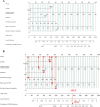Development and application of a risk nomogram for the prediction of risk of carbapenem-resistant Acinetobacter baumannii infections in neuro-intensive care unit: a mixed method study
- PMID: 38867312
- PMCID: PMC11170918
- DOI: 10.1186/s13756-024-01420-6
Development and application of a risk nomogram for the prediction of risk of carbapenem-resistant Acinetobacter baumannii infections in neuro-intensive care unit: a mixed method study
Erratum in
-
Correction: Development and application of a risk nomogram for the prediction of risk of carbapenem-resistant Acinetobacter baumannii infections in neuro-intensive care unit: a mixed method study.Antimicrob Resist Infect Control. 2024 Sep 27;13(1):109. doi: 10.1186/s13756-024-01469-3. Antimicrob Resist Infect Control. 2024. PMID: 39334456 Free PMC article. No abstract available.
Abstract
Objective: This study aimed to develop and apply a nomogram with good accuracy to predict the risk of CRAB infections in neuro-critically ill patients. In addition, the difficulties and expectations of application such a tool in clinical practice was investigated.
Methods: A mixed methods sequential explanatory study design was utilized. We first conducted a retrospective study to identify the risk factors for the development of CRAB infections in neuro-critically ill patients; and further develop and validate a nomogram predictive model. Then, based on the developed predictive tool, medical staff in the neuro-ICU were received an in-depth interview to investigate their opinions and barriers in using the prediction tool during clinical practice. The model development and validation is carried out by R. The transcripts of the interviews were analyzed by Maxqda.
Results: In our cohort, the occurrence of CRAB infections was 8.63% (47/544). Multivariate regression analysis showed that the length of neuro-ICU stay, male, diabetes, low red blood cell (RBC) count, high levels of procalcitonin (PCT), and number of antibiotics ≥ 2 were independent risk factors for CRAB infections in neuro-ICU patients. Our nomogram model demonstrated a good calibration and discrimination in both training and validation sets, with AUC values of 0.816 and 0.875. Additionally, the model demonstrated good clinical utility. The significant barriers identified in the interview include "skepticism about the accuracy of the model", "delay in early prediction by the indicator of length of neuro-ICU stay", and "lack of a proper protocol for clinical application".
Conclusions: We established and validated a nomogram incorporating six easily accessed indicators during clinical practice (the length of neuro-ICU stay, male, diabetes, RBC, PCT level, and the number of antibiotics used) to predict the risk of CRAB infections in neuro-ICU patients. Medical staff are generally interested in using the tool to predict the risk of CRAB, however delivering clinical prediction tools in routine clinical practice remains challenging.
Keywords: Carbapenem-resistant Acinetobacter baumannii infections; Mixed method study; Neuro-ICU patients; Prediction model.
© 2024. The Author(s).
Conflict of interest statement
The authors declare no competing interests.
Figures





Similar articles
-
Antibiotic strategies and clinical outcomes in critically ill patients with pneumonia caused by carbapenem-resistant Acinetobacter baumannii.Clin Microbiol Infect. 2018 Aug;24(8):908.e1-908.e7. doi: 10.1016/j.cmi.2017.10.033. Epub 2017 Nov 3. Clin Microbiol Infect. 2018. PMID: 29108947
-
Risk factors for occurrence and 30-day mortality for carbapenem-resistant Acinetobacter baumannii bacteremia in an intensive care unit.J Korean Med Sci. 2012 Aug;27(8):939-47. doi: 10.3346/jkms.2012.27.8.939. Epub 2012 Jul 25. J Korean Med Sci. 2012. PMID: 22876063 Free PMC article. Clinical Trial.
-
Insights into the epidemiology, risk factors, and clinical outcomes of carbapenem-resistant Acinetobacter baumannii infections in critically ill children.Front Public Health. 2023 Nov 30;11:1282413. doi: 10.3389/fpubh.2023.1282413. eCollection 2023. Front Public Health. 2023. PMID: 38098829 Free PMC article.
-
The incidence and prevalence of hospital-acquired (carbapenem-resistant) Acinetobacter baumannii in Europe, Eastern Mediterranean and Africa: a systematic review and meta-analysis.Emerg Microbes Infect. 2019;8(1):1747-1759. doi: 10.1080/22221751.2019.1698273. Emerg Microbes Infect. 2019. PMID: 31805829 Free PMC article.
-
Prevalence of Acinetobacter baumannii in Saudi Arabia: risk factors, antimicrobial resistance patterns and mechanisms of carbapenem resistance.Ann Clin Microbiol Antimicrob. 2019 Jan 3;18(1):1. doi: 10.1186/s12941-018-0301-x. Ann Clin Microbiol Antimicrob. 2019. PMID: 30606201 Free PMC article. Review.
References
-
- Chen SJ, Chao TF, Chiang MC, et al. Predictors of mortality in surgical patients with Acinetobacter baumannii bacteremia. J Microbiol Immunol Infect. 2011;44(3):209–14. 10.1016/j.jmii.2011.01.017. - PubMed
-
- Lee MH, Chen TL, Lee YT, et al. Dissemination of multidrug-resistant Acinetobacter baumannii carrying BlaOxA-23 from hospitals in central Taiwan. J Microbiol Immunol Infect. 2013;46(6):419–24. 10.1016/j.jmii.2012.08.006. - PubMed
-
- Nutman A, Glick R, Temkin E, et al. A case-control study to identify predictors of 14-day mortality following carbapenem-resistant Acinetobacter baumannii bacteraemia. Clin Microbiol Infect. 2014;20(12):O1028–34. 10.1111/1469-0691.12716. - PubMed
-
- Gales AC, Castanheira M, Jones RN, Sader HS. Antimicrobial resistance among Gram-negative bacilli isolated from Latin America: results from SENTRY Antimicrobial Surveillance Program (Latin America, 2008–2010). Diagn Microbiol Infect Dis. 2012;73(4):354–60. 10.1016/j.diagmicrobio.2012.04.007. - PubMed
MeSH terms
Substances
Grants and funding
- No. 82172603/National Natural Science Foundation of China
- BK20221280/Natural Science Foundation of Jiangsu Province
- YBK202202/Analysis and Knowledge Services of Yangzhou University
- 2022M711426/Chinese Postdoctoral Science Foundation
- M2022044/Jiangsu Province Health Commission New Technology Introduction and Evaluation Project
LinkOut - more resources
Full Text Sources

